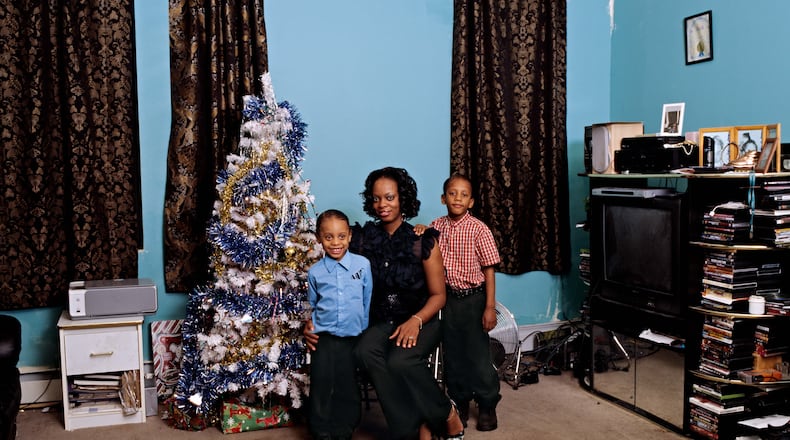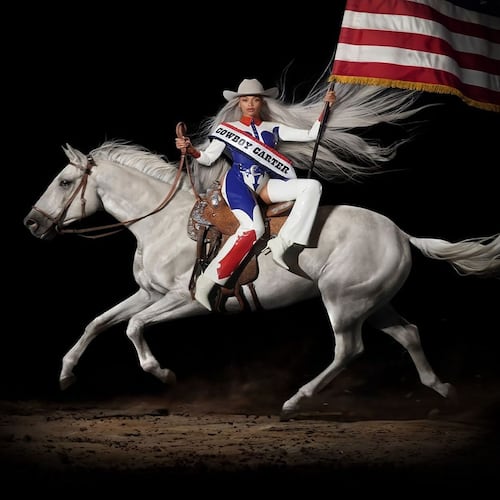Though they look like documentary images of people photographed in their living rooms and bedrooms, photographer Deana Lawson’s work — featured in a solo exhibition at the High Museum — is even more fascinating when you learn about its creation.
That origin story explains the mystical, cosmic aura that permeates Lawson’s photography.
Her work is a connection to life, as seen in the extraordinary image at the entrance to the show “The Beginning” of a mother prone on a bed with her newborn baby in the foreground, just pulled from her body. The show ends with a photo of a star in the solar system “Dana and Sirius B.” Birth and death, the void we emerge from and reenter are the bookends of this metaphysical show.
The Brooklyn-based Lawson takes her images around the world in the Democratic Republic of Congo, the South, Jamaica, among many other places, forging mystical connections between people.
To create her images, Lawson often photographs strangers she might meet on the subway, pass on the street or see in church. And she often orchestrates the settings where she photographs them — everything from decor to the outfits they wear. Though objects in the room seem random, coincidental — family photos, a child’s toys, food containers — they are all bit players in Lawson’s storytelling.
Credit: Deana Lawson
Credit: Deana Lawson
Her settings are portrait studios of a sort, like stage sets in a play about the human condition. Her images of Black men, women and children become chronicles of the beauty of ordinary lives and its pleasures and pathos.
“Deana Lawson” covers 15 years in the artist’s career and is the last stop in this, the first survey of Lawson’s work organized by the Institute of Contemporary Art/Boston and New York’s MoMA PS1. The exhibition blends those carefully composed, staged domestic portraits, along with found photography, advertising imagery, holograms and crystals Lawson has parked in the corners of the gallery like portals of interconnectivity.
Credit: Deana Lawson
Credit: Deana Lawson
Taken with a bulky view camera, the images blow the tiny, easy to hold and pass around scale of snapshots to poster size, changing their meaning with that dramatic enlargement, crafting something more monumental and cosmic.
As immersive as a film, taken together, the images become a slo-mo scroll, a montage of bodies and places all over the world that nevertheless feel tethered together in shared stories.
There are themes that reoccur throughout the show: sexual desire, love, adornment, family, ritual and self-actualization. The people in her frozen human dioramas wrap their arms around each other as in the tender intertwining of bodies in “Binky & Tony Forever,” in which a pretty young couple lean against a satiny gold bedspread in a spartan bedroom. In “Coulson Family” a mother and her two little boys stand in proud solidarity by their Christmas tree.
Credit: Deana Lawson
Credit: Deana Lawson
The photos have their own unique vernacular that combines the energy of family photos which commemorate a moment of togetherness and something that looks like advertisements for self. Lawson’s subjects stare out at the camera asking to be seen: as desirable, as attractive, as proud, as connected. Many of her photographs nod to the ways women have been represented in photography and art in the past. With Lawson’s emphasis on nude Black women, they can also make you feel uncomfortable and bring up questions of agency and objectification that have often swirled around Lawson’s art.
Female beauty as seen through a Black female artist’s viewfinder is a critical part of her work. In the charming image “Wanda and Daughters” a woman with an arrestingly direct gaze decked in silver jewelry poses with two little girls also ornamented with heads full of barrettes. It is an image of self-love, of ornamentation, that feels celebratory of how people distinguish and care for themselves. In “Diva at 73 Years Old” Lawson photographs a glamorous woman whose stylish jacket hangs open to reveal her breasts, a radical affirmation of a continuum of sexuality.
VISUAL ART REVIEW
“Deana Lawson”
Through Feb. 19. Timed tickets. 10 a.m.-5 p.m. Tuesdays-Saturdays; noon-5 p.m. Sundays. $16.50, ages 6 and above; free for children 5 and younger and members. High Museum of Art, 1280 Peachtree St. NE, Atlanta. 404-733-4444, high.org
Bottom line: Photographer Deana Lawson creates a genuinely captivating often tender — at times troubling for its reliance on Black female nudity — global story of desire, love, kinship and ornamentation in her portraits of Black subjects.
About the Author
Keep Reading
The Latest
Featured





